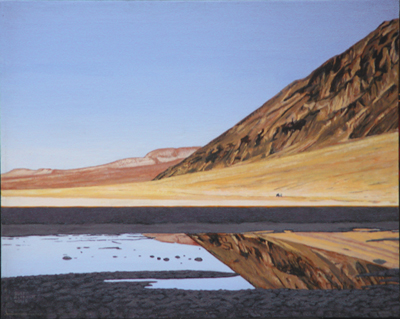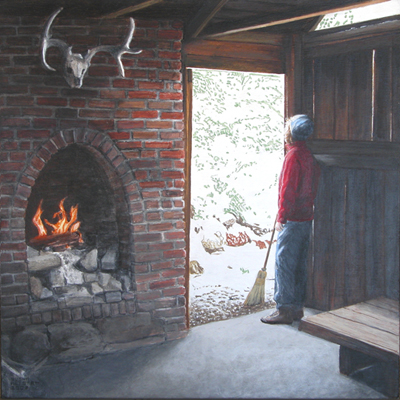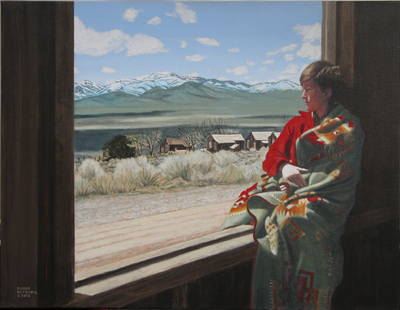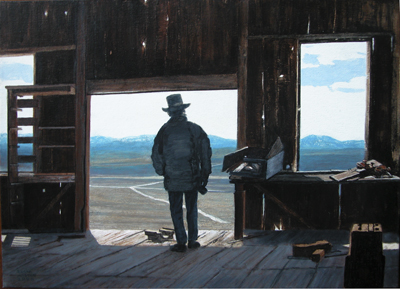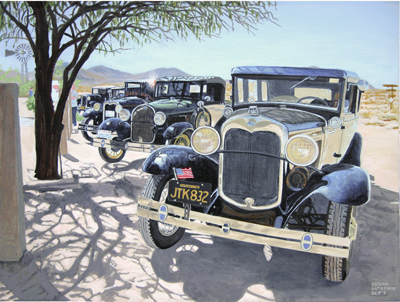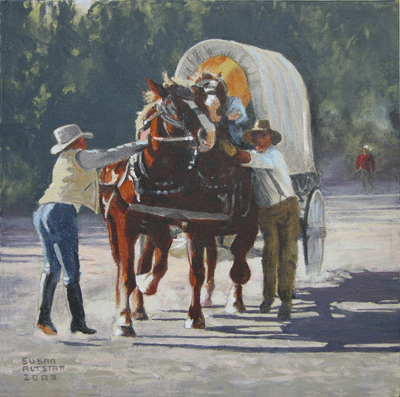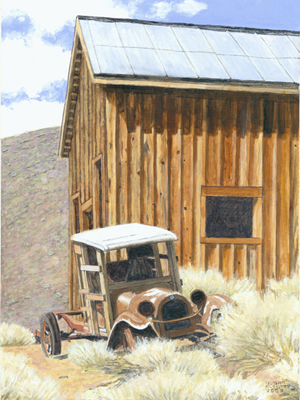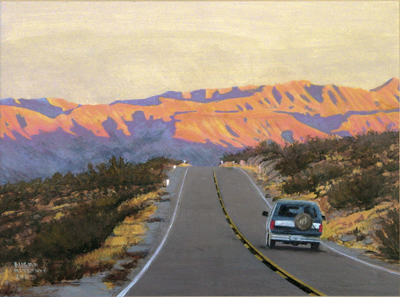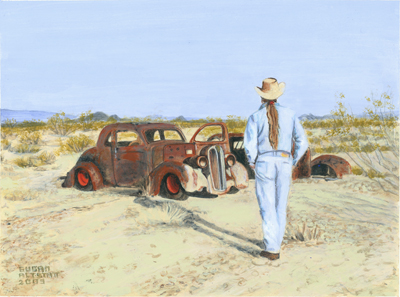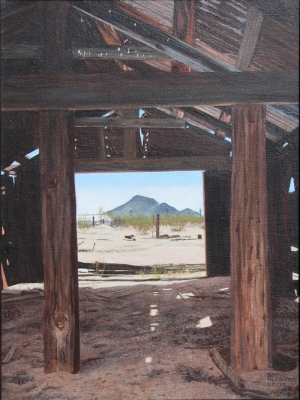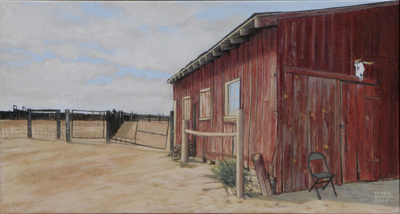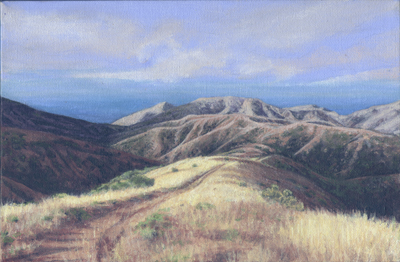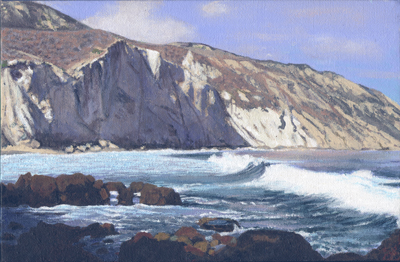Gallery Six: 2003
Several things happened in 2003. First I bought a digital camera and took it to Berlin Nevada. Digital photography freed me from the expense of film and the fear of wasting it. I am still painting from images harvested on that trip.
Secondly, I became intrigued with anonymous portraits, images of people which fascinate, not because the viewers know who they are, but because they want to know.
Thirdly, I realized my dissatisfaction with "empty" landscapes. When I look at a painting, I want someone to look back at me. A person, an animal, whatever. Old cars have faces and can look back at you, and they also stand as a surrogate for people who once owned them. Old buildings stand for the people who once lived in them. I realized that all the landscapes I had ever painted which did not have such a "protagonist" had strong indicators of the passage of time... sun rising or setting, storms (or trains) moving through. Many had roads running through them. Some of the roads had travelers. But on all roads, the viewer is a virtual traveler. This concept turns out to be as old as landscape painting itself. The first true landscapes, which were not mere backgrounds for portraits or religious subjects, were painted in Germany in the sixteenth century. They were protestant and iconoclastic in origin: take a painting of a hermit-saint living in the wilderness and remove the hermit. The viewer becomes the virtual saint. These early paintings are full of roads and travelers, standing for the viewer's progress through life.
|
Click on thumbnails for full image
Badwater
acrylic on canvas
16X20 inches
Death Valley, Inyo County CA
2003
acrylic on canvas
16X20 inches
Death Valley, Inyo County CA
2003
Having said all that, Badwater is a nearly empty landscape, but with a road, a car and a notion of time.
In Death Valley on a windless early morning, the shadow of the Funeral Mountains still lies on the alkali pools at Badwater. The extreme nature of the landscape and the clarity of the reflection produce a nearly abstract scene. A tiny SUV on the highway is the only indication of scale.
Snow
acrylic on canvas
20X20 inches
Union Canyon, Berlin Nevada
2003
acrylic on canvas
20X20 inches
Union Canyon, Berlin Nevada
2003
We went to Berlin in 2003 to meet with a group who were setting up a blacksmith shop furnished with items found at the site, and were also putting on a barn-dance in the old stamp mill. We arrived a day in advance and parked in the individual camp ground, intending to join our party in the group campground when they arrived. The weather was idyllic. And then, as is usual in Berlin, we woke to six inches of snow. I felt dismally certain our people would never make it across fifty miles of dirt road and two mountain ranges in that. But they did.
In the group campground stands a primitive cottage built by a university paleontologist during a dig there in the 1950's. The rangers opened it for our use. I got a fire going in the wonderful fireplace while another woman swept up.
"Hey," I said, "'suppose you could stand there in the doorway for a minute while I take some pictures?"
"Hey," I said, "'suppose you could stand there in the doorway for a minute while I take some pictures?"
The Chief Joseph Pattern
acrylic on canvas
22 X 28 inches
Berlin, Nevada
2003
acrylic on canvas
22 X 28 inches
Berlin, Nevada
2003
On the morning before the barn dance. there was a photo presentation in the stamp mill about beautiful outdoor dance-floors and bandstands built on old Mormon ranches. My daughter Ann was in the group, and I had asked her to wear something ambiguous enough to be taken for period dress. She wore a red shirt with a Mexican Calavera silk-screened on the back and torn-off black jeans, not exactly what I had in mind. But I told her to sit in the window.
 "Wait!" she said, "It's freezing!" and got the blanket, which I didn't know she'd brought along.
"Wait!" she said, "It's freezing!" and got the blanket, which I didn't know she'd brought along.
 Wrapped in that green and red design, her clothes are not obvious, her sex is ambiguous, and she becomes a microcosm of the scene outside.
Wrapped in that green and red design, her clothes are not obvious, her sex is ambiguous, and she becomes a microcosm of the scene outside.
Lookout
acrylic on canvas
18 X 24 inches
Berlin, Nevada
2003
acrylic on canvas
18 X 24 inches
Berlin, Nevada
2003
He's standing in the door of the machine shop in the old mining camp of Berlin, Nevada. The valley he's scanning is the Ione Valley, and the mountains beyond it are the Paradise Range. It's three miles to the crossroads. The rest of the story is up to you.
The Triumph of the Santa Fe
acrylic on canvas
10 X 30 inches
MDCHA headquarters, Goffs
San Bernardino County, CA
2003
acrylic on canvas
10 X 30 inches
MDCHA headquarters, Goffs
San Bernardino County, CA
2003
My friend Richard owned a scrap metal business, but he also has a strongly developed sense of aesthetics. When this old truck came his way, he knew it was just too nice to scrap. Still he felt it lacked something. So he welded up
the makeshift hoist, and fastened it to the rear, morphing it into an old-time tow truck. Then he trailered it out to the MDHCA property at Goffs, and positioned it in sight of the Santa Fe line.
On Route 66
acrylic on canvas
16 X 20 inches
MDCHA headquarters, Goffs
San Bernardino County, CA
2003
acrylic on canvas
16 X 20 inches
MDCHA headquarters, Goffs
San Bernardino County, CA
2003
Somebody hollered for me to grab my camera and get down to the Goffs Schoolhouse. And there, lined up against the front fence, were all the exquisitely restored darlings of the Paradise Valley Model A Club.
The Runaway Team
acrylic on canvas
12 X 12 inches
Furnace Creek
Death Valley, Inyo County, California
2003
acrylic on canvas
12 X 12 inches
Furnace Creek
Death Valley, Inyo County, California
2003
This is from the only photograph out of all the many I have taken at the arrival of the Death Valley Wagon Train that I could use as it was, with no omissions or alterations.
One Old Dodge
acrylic on paper
Berlin State Park, Nevada
2003
acrylic on paper
Berlin State Park, Nevada
2003
The fact that I am not a plein aire painter is an understatement. 2003 was the first time I entered the Death Valley plein aire competition, which meant for me, not painting the scene before me in the loosest of impressionist style, but seeing if I could do what I normally do, and finish in two days.
And to choose the scene I wanted for this purpose, I painted three different ones on paper, which is speedier for me than canvas. I decided against the old Dodge because of all the boards on the building.
And to choose the scene I wanted for this purpose, I painted three different ones on paper, which is speedier for me than canvas. I decided against the old Dodge because of all the boards on the building.
Bronco
acrylic on paper
Inyo County. California
2003
acrylic on paper
Inyo County. California
2003
I was out of the truck trying to photograph wild burros, but they were black and far away, and the light was fading. Then the Bronco hurtled by.
Red Wheels
Acrylic on paper
MDHCA headquarters, Goffs
San Bernardino County, California
2003
Acrylic on paper
MDHCA headquarters, Goffs
San Bernardino County, California
2003
Here is my choice. The two old cars, familiarly known as "Bonnie and Clyde"
are on the MDHCA property. My husband (with the ponytail) and I were looking at them early in the morning. I obviously did not win the competition, because the rules say the subject must be in Death Valley. But it auctioned well.
Fenner, Westbound
acrylic on canvas
Fenner, San Bernardino County, California
2003
acrylic on canvas
Fenner, San Bernardino County, California
2003
I have painted the Santa Fe at Goffs so many times, I expect to run out of new angles and new ways to present it. But it hasn't happened yet.
The Shed
acrylic on canvas
MDCHA headquarters, Goffs
San Bernardino County, California
2003
acrylic on canvas
MDCHA headquarters, Goffs
San Bernardino County, California
2003
I don't know what the shed was for. Its timbers are huge, its materials all re-used from somewhere else. And now the clean desert has blown in and erased any trace of former occupants. The shed and the schoolhouse are the oldest buildings remaining in Goffs, all that's left of the little railroad town. That's Goffs Butte in the background.
And When I Am Gone, Who Will Remember?
Acrylic on canvas
12 X 16 inches
OX Ranch
San Bernardino County, California
2003
Acrylic on canvas
12 X 16 inches
OX Ranch
San Bernardino County, California
2003
A year after the Overson's sold the OX Ranch in Lanfair Valley and took their cattle away to Arizona, but a year before disuse and the wind took the roof off the old barn, my camera and I got through the fence to see what images we could harvest off the OX abandoned.
Willows Road
acrylic on canvas
8 X 12 inches
Santa Cruz Island
2003
acrylic on canvas
8 X 12 inches
Santa Cruz Island
2003
Painted for auction at the Santa Barbara Channelkeeper organization annual fundraiser.
Valley Anchorage
acrylic on canvas
8 X 12 inches
Santa Cruz Island
2003
acrylic on canvas
8 X 12 inches
Santa Cruz Island
2003
Also painted for auction at the Santa Barbara Channelkeeper organization annual fundraiser. I did two because they were small.
All images Copyright © Susan Altstatt. Please contact before using
